Concrete Composites Based on Quaternary Blended Cements with a Reduced Width of Initial Microcracks
Abstract
:1. Introduction
- Acceleration of destruction of the material from which the structure is made;
- Shortening the life of the structure;
- Reducing the level of structure operation reliability;
- Making impossible to ensure an adequate level of structure safety;
- The need for more frequent and costly repairs.
- Excellent mechanical parameters, i.e., with the results exceeding the results obtained for unmodified concrete by several dozen percent;
- Fracture toughness increased by several to several dozen percent;
- A more stable crack propagation process;
- A more homogenous structure of the cement matrix.
- Significant reduction of CO2 emission;
- Reduction of electricity and heat energy;
- The possibility of waste management.
- The width of microcracks (Wc) occurring in the ITZ area of concretes based on quaternary blended cements;
- Changes in ITZ morphology in the concretes in question.
2. Scope of the Experimental Study
- Constant SF content, equal to 10%, and nS in the amount of 5%;
- Variable FA content, the amounts of which were, respectively: 0, 5, and 15%.
3. Materials and Methods
3.1. Materials
3.1.1. Aggregates
3.1.2. Binders
- OPC CEM I 32.5 R;
- Siliceous FA;
- Non-condensed SF;
- nS Konasil K-200.
3.1.3. Water
3.1.4. Admixture
3.2. Mixture Design and Manufacturing Process
- FaWag TP150/1 1D34ABM (range: 1–150 kg);
- RadWag WLC 30/C1/R (range: 0–30 kg).
- Mix gravel and sand in a drum mixer for 120 s;
- Add the binding materials, i.e., OPC, FA, and SF, and mix for 180 s;
- Add the mixture of water, SP, and nS, and mix for 120 s;
- Add the remaining water and mix to obtain a homogenous mixture for 120–180 s.
3.3. SEM Samples and SEM Studies
4. Results and Discussion
- Main phases occurring in the cement matrix,
- Areas of microcracks in the ITZ area, with the indication of their exact dimensions in three places,
- Areas of occurrence of FA grains in the paste structure,
- Voids after separation of FA grains from the cement matrix.
- Homogenization of the composite structure;
- Limitation of initial internal damages in concrete.
- By almost 40% in the case of QBC-1 series concrete;
- By almost half in the concrete of the QBC-2 series;
- By 30% in concrete of the QBC-3 series.
5. Conclusions
- The addition of three pozzolanic materials, i.e., FA, SF, and nS in combination, modifies the microstructure of the cement matrix and ITZ area.
- Reference concrete is characterized by greater microcrack width in the ITZ area in comparison to the concretes based on quaternary blended cements.
- The smallest microcracks occur in concrete with 10%SF+5%FA+5%nS. This shows that the composite of the QBC-2 series is characterized by high durability.
- In the case of concretes modified with three active pozzolanic materials, the sizes of microcracks in the ITZ between the coarse aggregate and the paste are clearly reduced.
Funding
Institutional Review Board Statement
Informed Consent Statement
Data Availability Statement
Conflicts of Interest
References
- Liu, F.; Zou, Y.; Wang, B.; Yuan, X. The Effect of Stray Current on Calcium Leaching of Cement-Based Materials. Materials 2022, 15, 2279. [Google Scholar] [CrossRef] [PubMed]
- Wardach, M.; Krentowski, J.R.; Mackiewicz, M. Evaluation of precast beam deflections resulting in cracks in curtain walls. Eng. Fail. Anal. 2022, 140, 106568. [Google Scholar] [CrossRef]
- Golewski, G.L. The specificity of shaping and execution of monolithic pocket foundations (PF) in hall buildings. Buildings 2022, 12, 192. [Google Scholar] [CrossRef]
- Miraldo, S.; Lopes, S.; Pcheco-Torgal, F.; Lopes, A. Advantages and shortcomings of the utilization of recycled wastes as aggregates in structural concretes. Constr. Build. Mater. 2021, 298, 123729. [Google Scholar] [CrossRef]
- Kovacik, J.; Marsavina, L.; Linul, E. Poisson’s ratio of closed-cell aluminum foams. Materials 2018, 11, 1904. [Google Scholar] [CrossRef] [Green Version]
- Zhang, P.; Wang, C.; Gao, Z.; Wang, F. A Review on Fracture Properties of Steel Fiber Reinforced Concrete. J. Build. Eng. 2023, 67, 105975. [Google Scholar] [CrossRef]
- Abdulrahman, H.; Muhamad, R.; Visitin, P.; Shukri, A.A. Mechanical properties and bond stress-slip behaviour of fly ash geopolymer concrete. Constr. Build. Mater. 2022, 327, 126909. [Google Scholar] [CrossRef]
- Craciun, E.M. Energy criteria for crack propagation in prestresses elastic composites. Sol. Mech. Appl. 2008, 154, 193–237. [Google Scholar]
- Golewski, G.L.; Szostak, B. Strength and Microstructure of Composites with Cement Matrixes Modified by Fly Ash and Active Seeds of C-S-H Phase. Struct. Eng. Mech. 2022, 82, 543–556. [Google Scholar]
- Kong, Y.; Wang, P.; Liu, S.; Zhao, G.; Peng, Y. SEM Analysis of the Interfacial Transition Zone between Cement-Glass Powder Paste and Aggregate of Mortar under Microwave Curing. Materials 2016, 9, 733. [Google Scholar] [CrossRef] [Green Version]
- Shahsavar, S.; Fakoor, M.; Berto, F. Mixed Mode I/II Fracture Criterion to Anticipate Cracked Composite Materials Based on Reinforced Kinked Crack Along Maximum Shear Stress Path. Stell Compos. Struct. 2021, 39, 765–779. [Google Scholar]
- Golewski, G.; Sadowski, T. Fracture Toughness at Shear (Mode II) of Concretes Made of Natural and Broken Aggregates. Brittle Matrix Compos. 2006, 8, 537–546. [Google Scholar]
- Hashemmoniri, S.; Fatemi, A. Optimization of Lightweight Foamed Concrete Using Fly Ash Based on Mechanical Properties. Inn. Infrastruct. Sol. 2023, 8, 59. [Google Scholar] [CrossRef]
- Reis, J.M.L.; Chianelli-Junior, R.; Cardoso, J.L.; Marinho, F.J.V. Effect of Recycled PET in the Fracture Mechanics of Polymer Mortar. Constr. Build. Mater. 2011, 25, 2799–2804. [Google Scholar] [CrossRef] [Green Version]
- Golewski, G.L.; Sadowski, T. Macroscopic Evaluation of Fracture Processes in Fly Ash Concrete. Sol. State. Phenom. 2016, 254, 188–193. [Google Scholar] [CrossRef]
- Li, X.; Zhang, Q. Influence Behavior of Phosphorus Slag and Fly Ash on the Interface Transition Zone in Concrete Prepared by Cement-Red Mud. J. Build. Eng. 2021, 49, 104017. [Google Scholar] [CrossRef]
- Rong, G.; He, T.; Zhang, G.; Li, Y.; Wang, Y.; Xie, W. A Review on Chloride Transport Model and Research Method in Concrete. Mater. Res. Express 2023, 10, 042002. [Google Scholar] [CrossRef]
- Golewski, G.L. Changes in the Fracture Toughness under Mode II Loading of Low Calcium Fly Ash (LCFA) Concrete Depending on Ages. Materials 2020, 13, 5241. [Google Scholar] [CrossRef]
- Fu, Q.; Zhang, Z.; Wang, Z.; He, J.; Niu, D. Erosion Behavior of Ions in Lining Concrete Incorporating Fly Ash and Silica Fume under the Combined Action of Load and Flowing Groundwater Containing Composite Salt. Case Stud. Constr. Mater. 2022, 17, e01659. [Google Scholar] [CrossRef]
- Gil, D.M.; Golewski, G.L. Potential of Siliceous Fly Ash and Silica Fume as a Substitute of Binder in Cementitious Concrete. E3S Web Conf. 2018, 49, 00030. [Google Scholar] [CrossRef] [Green Version]
- Riccio, A.; Castaldo, R.; Palumbo, C.; Russo, A. Delamination Effect on the Buckling Behaviour of Carbon–Epoxy Composite Typical Aeronautical Panels. Appl. Sci. 2023, 13, 4358. [Google Scholar] [CrossRef]
- Golewski, G.L. The Phenomenon of Cracking in Cement Concretes and Reinforced Concrete Structures: The Mechanism of Cracks Formation, Causes of Their Initiation, Types and Places of Occurrence, and Methods of Detection—A Review. Buildings 2023, 13, 765. [Google Scholar] [CrossRef]
- Golewski, G.L. Determination of Fracture Toughness in Concretes Containing Siliceous Fly Ash during Mode III Loading. Struct. Eng. Mech. 2017, 62, 1–9. [Google Scholar] [CrossRef]
- Chen, S.; Wang, H.; Guan, J.; Yao, X.; Li, L. Determination Method and Prediction Model of Fracture and Strength of Recycled Aggregate Concrete at Different Curing Ages. Constr. Build. Mater. 2022, 343, 128070. [Google Scholar] [CrossRef]
- Guan, J.; Yin, Y.; Li, Y.; Yao, X.; Li, L. A Design Method for Determining Fracture Toughness and Tensile Strength Pertinent to Concrete Sieving Curve. Eng. Fract. Mech. 2022, 271, 108596. [Google Scholar] [CrossRef]
- Wei, J.; Liu, J.; Khayat, K.H.; Long, W.-J. Synergistic Effect of HEDP.4Na and Different Induced Pouring Angles on Mechanical Properties of Fiber-Reinforced Alkali-Activated Slag Composites. Fibers 2023, 11, 23. [Google Scholar] [CrossRef]
- Golewski, G.L. Combined Effect of Coal Fly Ash (CFA) and Nanosilica (Ns) on the Strength Parameters and Microstructural Properties of Eco-Friendly Concrete. Energies 2023, 16, 452. [Google Scholar] [CrossRef]
- Suchorab, Z.; Franus, M.; Barnat-Hunek, D. Properties of Fibrous Concrete Made with Plastic Fibers from E-Waste. Materials 2020, 13, 2414. [Google Scholar] [CrossRef]
- Golewski, G.L.; Sadowski, T. A Study on Mode III Fracture Toughness in Young and Mature Concrete with Fly Ash Additive. Solid State Phenom. 2016, 254, 120–125. [Google Scholar] [CrossRef]
- Ahmad, J.; Zaid, O.; Shahzaib, M.; Usman Abdullah, M.; Ullah, A.; Ullah, R. Mechanical properties of sustainable concrete modified by adding marble slurry cement substitution. AIMS Mater. Sci. 2021, 8, 343–358. [Google Scholar] [CrossRef]
- Pacheco-Torgal, F. High Tech Startup Creation for Energy Efficient Built Environment. Renew. Sustain. Energy Rev. 2017, 71, 618–629. [Google Scholar] [CrossRef] [Green Version]
- Alex, A.G.; Kemal, Z.; Gebrehiwet, T.; Getahun, S. Effect of a: Phase Nano Al2O3 and Rice Husk Ash in Cement Mortar. Adv. Civ. Eng. 2022, 2022, 4335736. [Google Scholar] [CrossRef]
- Wang, L.; Zhang, P.; Golewski, G.L.; Guan, J. Editorial: Fabrication and Properties of Concrete Containing Industrial Waste. Front. Mater. 2023, 10, 1169715. [Google Scholar] [CrossRef]
- Szcześniak, A.; Zychowicz, J.; Stolarski, A. Influence of Fly Ash Additive on the Properties of Concrete with Slag Cement. Materials 2020, 13, 3265. [Google Scholar] [CrossRef]
- Xie, T.; Yang, G.; Zhao, X.; Xu, J.; Fang, C. A unified model for predicting the compressive strength of recycled aggregate concrete containing supplementary cementitious materials. J. Clean. Prod. 2020, 251, 119752. [Google Scholar] [CrossRef]
- Golewski, G.L. Studies of natural radioactivity of concrete with siliceous fly ash addition. Cem. Wapno Beton 2015, 2, 106–114. [Google Scholar]
- Adam, M.G.O.; Koteng, D.O.; Ng’ang’a Thuo, J.; Matallah, M. Effects of Acid Attack and Cassava Flour Dosage on the Interfacial Transition Zone Thickness, Durability and Mechanical Characteristics of High-Strength (HS) Concrete. Res. Eng. 2023, 17, 101001. [Google Scholar]
- Aghajanian, A.; Cimentada, A.; Fayyaz, M.; Brand, A.S.; Thomasa, C. ITZ Microanalysis of Cement-Based Building Materials with Incorporation of Siderurgical Aggregates. J. Build. Eng. 2023, 67, 106008. [Google Scholar] [CrossRef]
- Golewski, G.L. Mechanical Properties and Brittleness of Concrete Made by Combined Fly Ash, Silica Fume and Nanosilica with ordinary Portland cement. AIMS Mater. Sci. 2023, 10, 390–404. [Google Scholar] [CrossRef]
- Zeyad, A.M.; Tayeh, B.A.; Yusuf, M.O. Strength and transport characteristics of volcanic pumice powder based high strength concrete. Constr. Build. Mater. 2019, 216, 314–324. [Google Scholar] [CrossRef]
- Gao, Y.; Jing, H.; Yu, Z.; Li, L.; Wu, J.; Chen, W. Particle size distribution of aggregate effects on the reinforcing roles of carbon nanotubes in enhancing concrete ITZ. Constr. Build. Mater. 2022, 327, 126964. [Google Scholar] [CrossRef]
- Fattouh, M.S.; Elsayed, E.K. Influence of Utilizing Glass Powder with Silica Fume on Mechanical Properties and Microstructure of Concrete. Delta Univ. Sci. J. 2023, 6, 111–122. [Google Scholar] [CrossRef]
- Golewski, G.L. The Role of Pozzolanic Aactivity of Siliceous Fly Ash in the Formation of the Structure of Sustainable Cementitious Composites. Sustain. Chem. 2022, 3, 520–534. [Google Scholar] [CrossRef]
- Huang, H.-S.; Zhang, H.-Y.; Lv, Y.-M.; Chen, Y.-J. Performance and Optimization Design of High-Strength Geopolymer Cold-bonded Lightweight Aggregate: Effect of Silica Fume. Case Stud. Constr. Mater. 2023, 18, e02047. [Google Scholar] [CrossRef]
- Lopes, A.; Lopes, S.; Fernandes, M. Time Evolution of the Modulus of Elasticity of Metakaolin-Based Geopolymer. Appl. Sci. 2023, 13, 2179. [Google Scholar] [CrossRef]
- Neves, A.; Almeida, J.; Cruz, F.; Miranda, T.; Cunha, V.M.C.F.; Rodrigues, M.; Costa, J.; Pereira, E.B. Design Procedures for Sustainable Structural Concretes Using Wastes and Industrial By-Products. Appl. Sci. 2023, 13, 2087. [Google Scholar] [CrossRef]
- Zhang, W.; Liu, H.; Liu, C. Impact of Rice Husk Ash on the Mechanical Characteristics and Freeze–Thaw Resistance of Recycled Aggregate Concrete. Appl. Sci. 2022, 12, 12238. [Google Scholar] [CrossRef]
- Kuri, J.C.; Hosan, A.; Shaikh, F.U.A.; Biswas, W.K. The Effect of Recycled Waste Glass as a Coarse Aggregate on the Properties of Portland Cement Concrete and Geopolymer Concrete. Buildings 2023, 13, 586. [Google Scholar] [CrossRef]
- Golewski, G.L. Effect of Fly Ash Addition on the Fracture Toughness of Plain Concrete at Third Model of Fracture. J. Civ. Eng. Manag. 2017, 23, 613–620. [Google Scholar] [CrossRef] [Green Version]
- Alyousef, R.; Abbass, W.; Aslam, F.; Ali Gillani, S.A. Characterization of High-Performance Concrete using Limestone Powder and Supplementary Fillers in Binary and Ternary Blends under Different Curing Regimes. Case Stud. Constr. Mater. 2023, 18, e02058. [Google Scholar] [CrossRef]
- Gil, D.M.; Golewski, G.L. Effect of Silica Fume and Siliceous Fly Ash Addition on the Fracture Toughness of Plain Concrete in Mode I. IOP Conf. Ser. Mater. Sci. Eng. 2018, 416, 012065. [Google Scholar] [CrossRef]
- Golewski, G.L. Study of Strength and Microstructure of a New Sustainable Concrete Incorporating Pozzolanic Materials. Struct. Eng. Mech. 2023, 86, 431–441. [Google Scholar]
- Wang, J.; Lu, X.; Ma, B.; Tan, H. Cement-Based Materials Modified by Colloidal Nano-Silica: Impermeability Characteristic and Microstructure. Nanomaterials 2022, 12, 3176. [Google Scholar] [CrossRef] [PubMed]
- Zhang, P.; Su, J.; Guo, J.; Hu, S. Influence of Carbon Nanotube on Properties of Concrete: A Review. Constr. Build. Mater. 2023, 369, 130388. [Google Scholar] [CrossRef]
- Zhang, P.; Wang, M.; Han, X.; Zheng, Y. A Review on Properties of Cement-Based Composites Doped with Graphene. J. Build. Eng. 2023, 70, 106367. [Google Scholar] [CrossRef]
- Kathirvel, P.; Murali, G. Effect of using Available GGBFS, Silica Fume, Quartz Powder and Steel Fibres on the Fracture Behavior of Sustainable Reactive Powder Concrete. Constr. Build. Mater. 2023, 375, 130997. [Google Scholar] [CrossRef]
- Yuan, B.; Wang, H.; Jin, D.; Chen, W. C-S-H Seeds Accelerate Early Age Hydration of Carbonate-Activated Slag and the Underlying Mechanism. Materials 2023, 16, 1394. [Google Scholar] [CrossRef]
- Cuesta, A.; Morales-Cantero, A.; De la Torre, A.G.; Aranda, M.A.G. Recent Advances in C-S-H Nucleation Seeding for Improving Cement Performances. Materials 2023, 16, 1462. [Google Scholar] [CrossRef]
- Golewski, G.L. Generalized Fracture Toughness and Compressive Strength of Sustainable Concrete Including Low Calcium Fly Ash. Materials 2017, 10, 1393. [Google Scholar] [CrossRef] [Green Version]
- Sun, D.; Huang, W.; Liu, K.; Ma, R.; Wang, A.; Guan, Y.; Shen, S. Effect of the Moisture Content of Recycled Aggregate on the Mechanical Performance and Durability of Concrete. Materials 2022, 15, 6299. [Google Scholar] [CrossRef]
- Tang, W.; Khavarian, M.; Yousefi, A.; Landenberger, B.; Cui, H. Influence of Mechanical Screened Recycled Coarse Aggregates on Properties of Self-Compacting Concrete. Materials 2023, 16, 1483. [Google Scholar] [CrossRef] [PubMed]
- Zhang, B.; Zhu, H.; Lu, F. Fracture Properties of Slag-Based Alkali-Activated Seawater Coral Aggregate. Theor. Appl. Fract. Mech. 2019, 115, 103071. [Google Scholar] [CrossRef]
- Sun, Z.; Xiong, J.; Cao, S.; Zhu, J.; Jia, X.; Hu, Z.; Liu, K. Effect of Different Fine Aggregate Characteristics on Fracture Toughness and Microstructure of Sand Concrete. Materials 2023, 16, 2080. [Google Scholar] [CrossRef] [PubMed]
- Golewski, G.L. An assessment of microcracks in the Interfacial Transition Zone of durable concrete composites with fly ash additives. Compos. Struct. 2018, 200, 515–520. [Google Scholar] [CrossRef]
- He, W.; Li, B.; Meng, X.; Shen, Q. Compound Effects of Sodium Chloride and Gypsum on the Compressive Strength and Sulfate Resistance of Slag-Based Geopolymer Concrete. Buildings 2023, 13, 675. [Google Scholar] [CrossRef]
- Golewski, G.L. Fracture Performance of Cementitious Composites Based on Quaternary Blended Cements. Materials 2022, 15, 6023. [Google Scholar] [CrossRef]
- Dipta, O.B.; Sobhan, S.F.; Shuvo, A.K. Assessment of the Combined Effect of Silica Fume, Fly Ash, and Steel Slag on the Mechanical Behavior of Concrete. J. Civ. Eng. Constr. 2023, 12, 78–85. [Google Scholar] [CrossRef]
- Ramesh, G. Green concrete: Environment friendly solution. Ind. J. Des. Eng. 2021, 1, 13–20. [Google Scholar]
- Golewski, G.L.; Sadowski, T. Experimental Investigation and Numerical Modelling Fracture Processes in Fly Ash Concrete at Early Age. Solid State Phenom. 2012, 188, 158–163. [Google Scholar] [CrossRef]
- Piyarat, N.; Wangrakdiskul, U.; Maingam, P. Investigations of the influence of various industrial waste materials containing rice husk ash, waste glass, and sediment soil for eco-friendly production of non-fired tiles. AIMS Mater. Sci. 2021, 8, 469–485. [Google Scholar] [CrossRef]
- Szostak, B.; Golewski, G.L. Effect of nano admixture of CSH on selected strength parameters of concrete including fly ash. IOP Conf. Ser. Mater. Sci. Eng. 2018, 416, 012105. [Google Scholar] [CrossRef]
- Golewski, G.L. An Extensive Investigations on Fracture Parameters of Concretes Based on Quaternary Binders (QBC) by Means of the DIC Technique. Constr. Build. Mater. 2022, 351, 128823. [Google Scholar] [CrossRef]
- EN 1008:2002; Mixing Water for Concrete—Specification for Sampling, Testing and Assessing the Suitability of Water, Including Water Recovered from Processes in the Concrete Industry, as Mixing Water for Concrete. British Standards Institution (BSI): London, UK, 2002.
- EN 12390-2:2019; Testing Hardened Concrete–Part 2: Making and Curing Specimens for Strength Tests. British Standards Institution (BSI): London, UK, 2019.
- Zhang, M.H. Microstructure, Crack Propagation, and Mechanical Properties of Cement Pastes Containing High Volumes of Fly Ashes. Cem. Concr. Res. 1995, 25, 1165–1178. [Google Scholar] [CrossRef]
- Ho, D.W.S.; Lewis, R.K. Effectiveness of Fly Ash for Strength and Durability of Concrete. Cem. Concr. Res. 1985, 15, 793–800. [Google Scholar] [CrossRef]
- Fraay, A.L.A.; Bijen, J.M.; de Haan, Y.M. The Reaction of Fly Ash in Concrete. A Critical Examination. Cem. Concr. Res. 1989, 19, 235–246. [Google Scholar] [CrossRef]
- Lam, L.; Wong, Y.L.; Poon, C.S. Effect of Fly Ash and Silica Fume on Compressive and Fracture Behaviors of Concrete. Cem. Concr. Res. 1998, 28, 271–283. [Google Scholar] [CrossRef]
- Patel, N.; Dave, R.; Modi, S.; Joshi, C.; Vora, S.; Solanki, M. Effect of Binary and Quaternary Blends on Compressive Strength. Int. J. Civ. Eng. Technol. 2016, 7, 242–246. [Google Scholar]
- El-Chabib, H.; Ibrahim, A. The Performance of High-strength Flowable Concrete Made with Binary, Ternary, or Quaternary Binder in Hot Climate. Constr. Build. Mater. 2013, 47, 245–253. [Google Scholar] [CrossRef]
- Golewski, G.L. Comparative Measurements of Fracture Toughness Combined with Visual Analysis of Cracks Propagation Using the DIC Technique of Concretes Based on Cement Matrix with a Highly Diversified Composition. Theor. Appl. Fract. Mech. 2022, 121, 103553. [Google Scholar] [CrossRef]
- Golewski, G.L. An Analysis of Fracture Toughness in Concrete with Fly Ash Addition, Considering All Models of Cracking. IOP Conf. Ser. Mater. Sci. Eng. 2018, 416, 012029. [Google Scholar] [CrossRef] [Green Version]

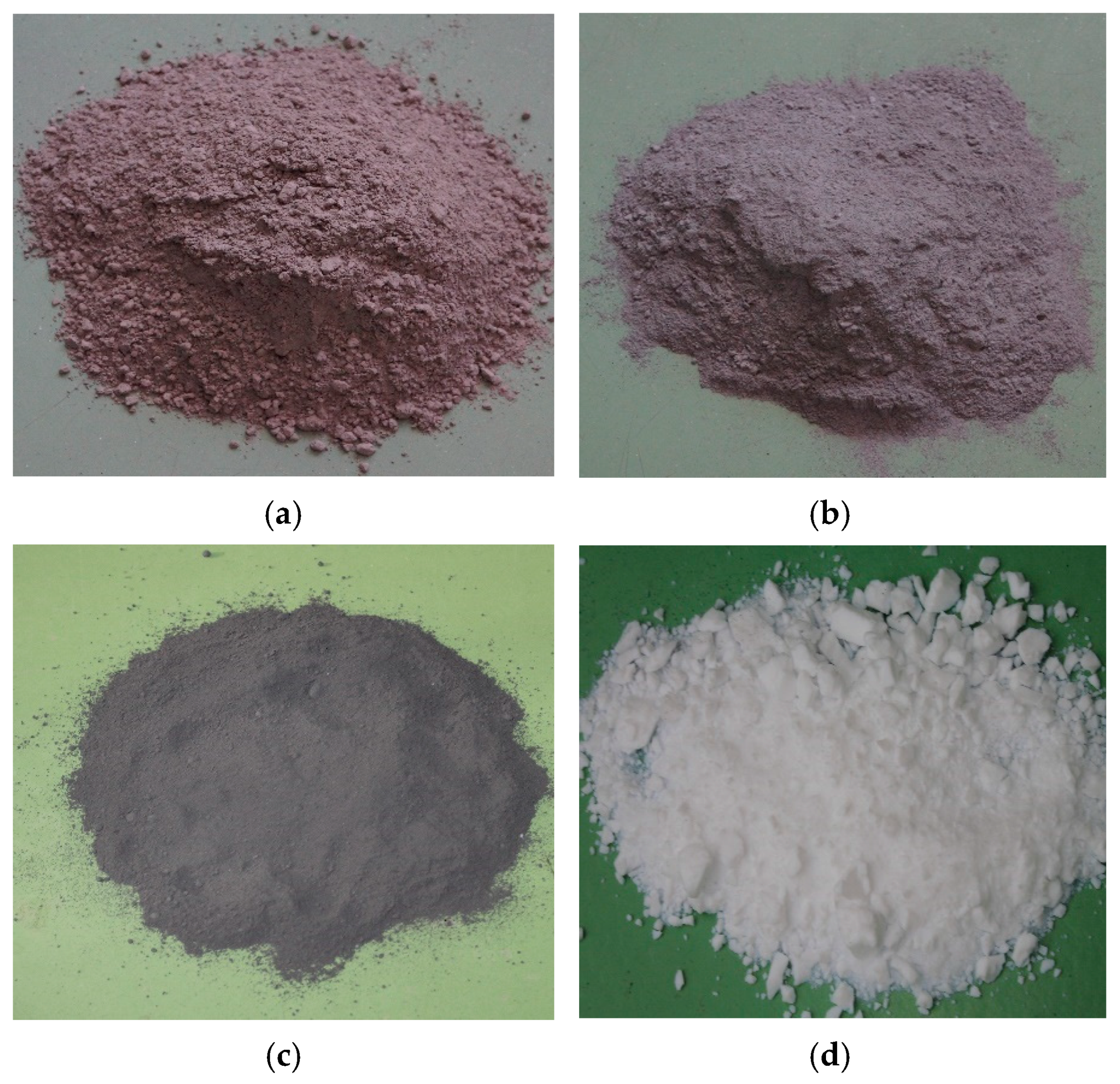


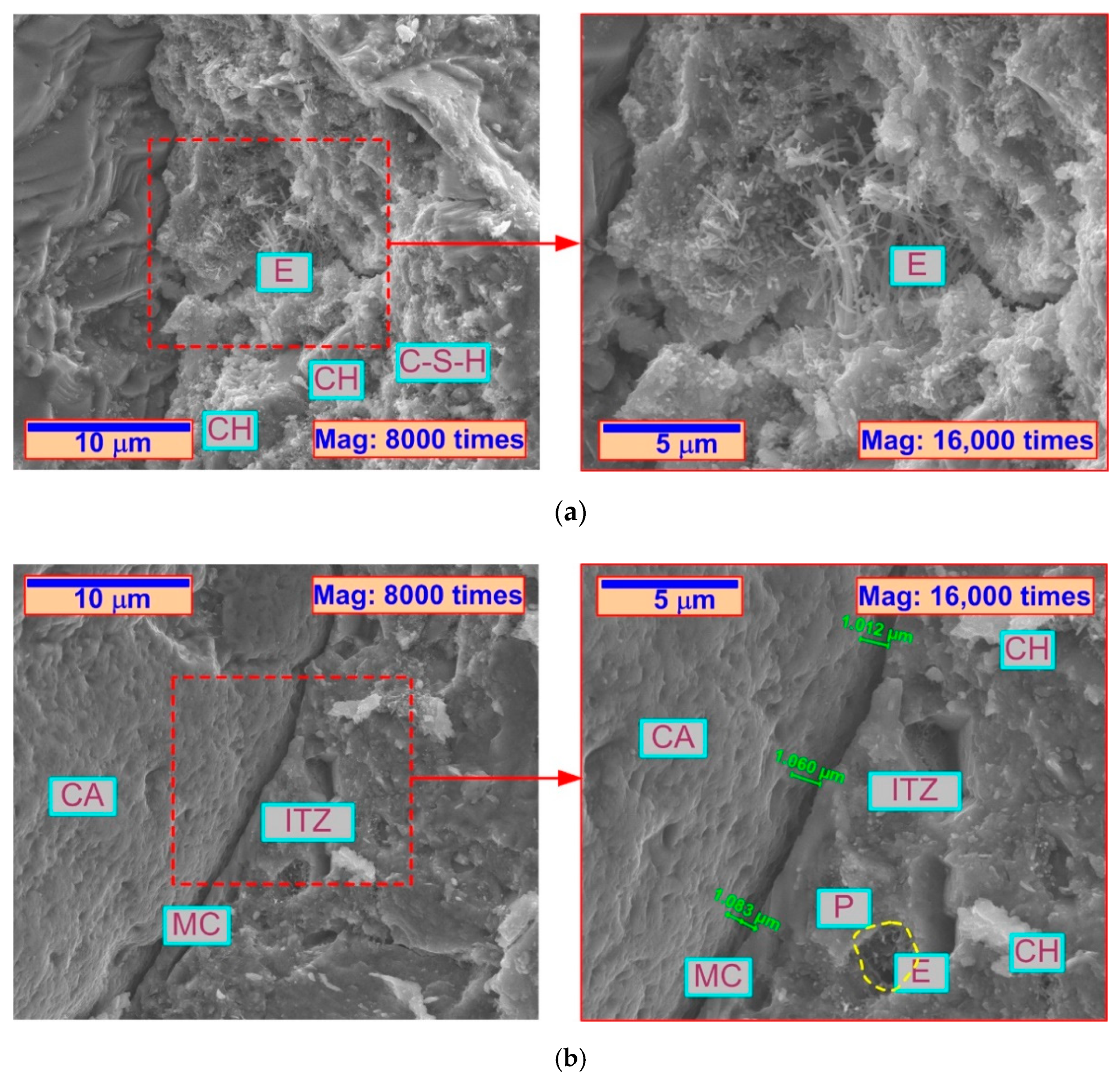
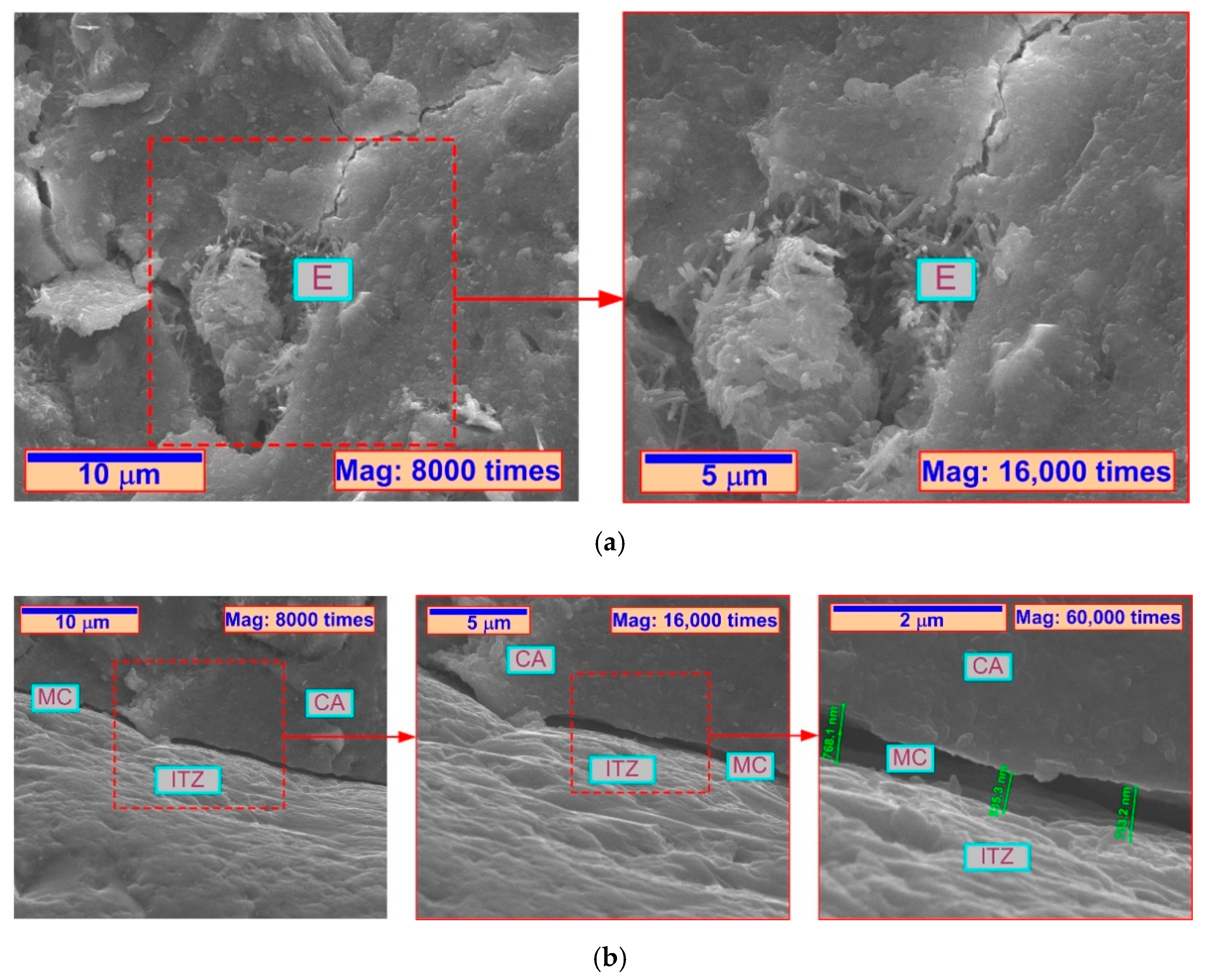
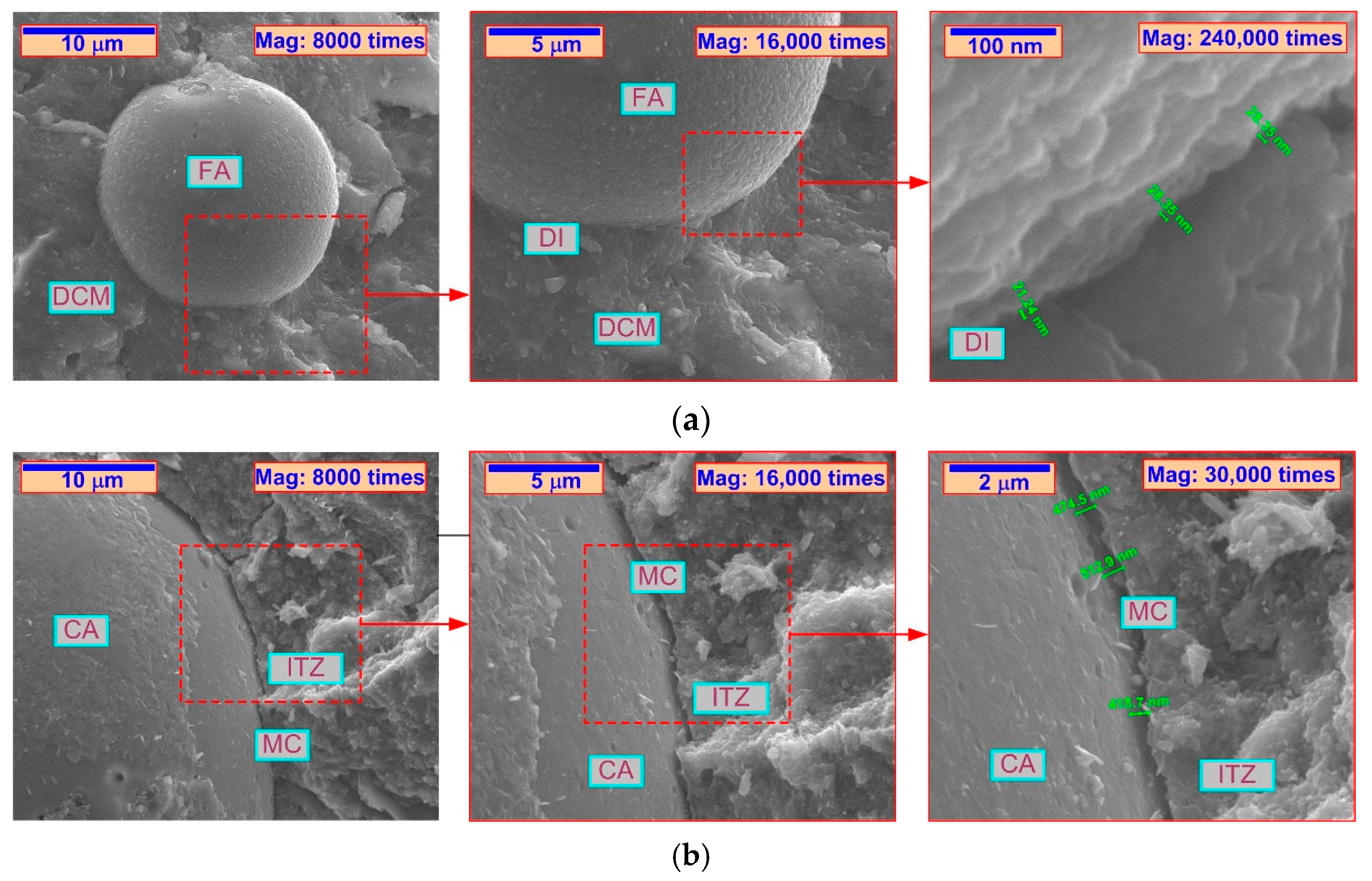

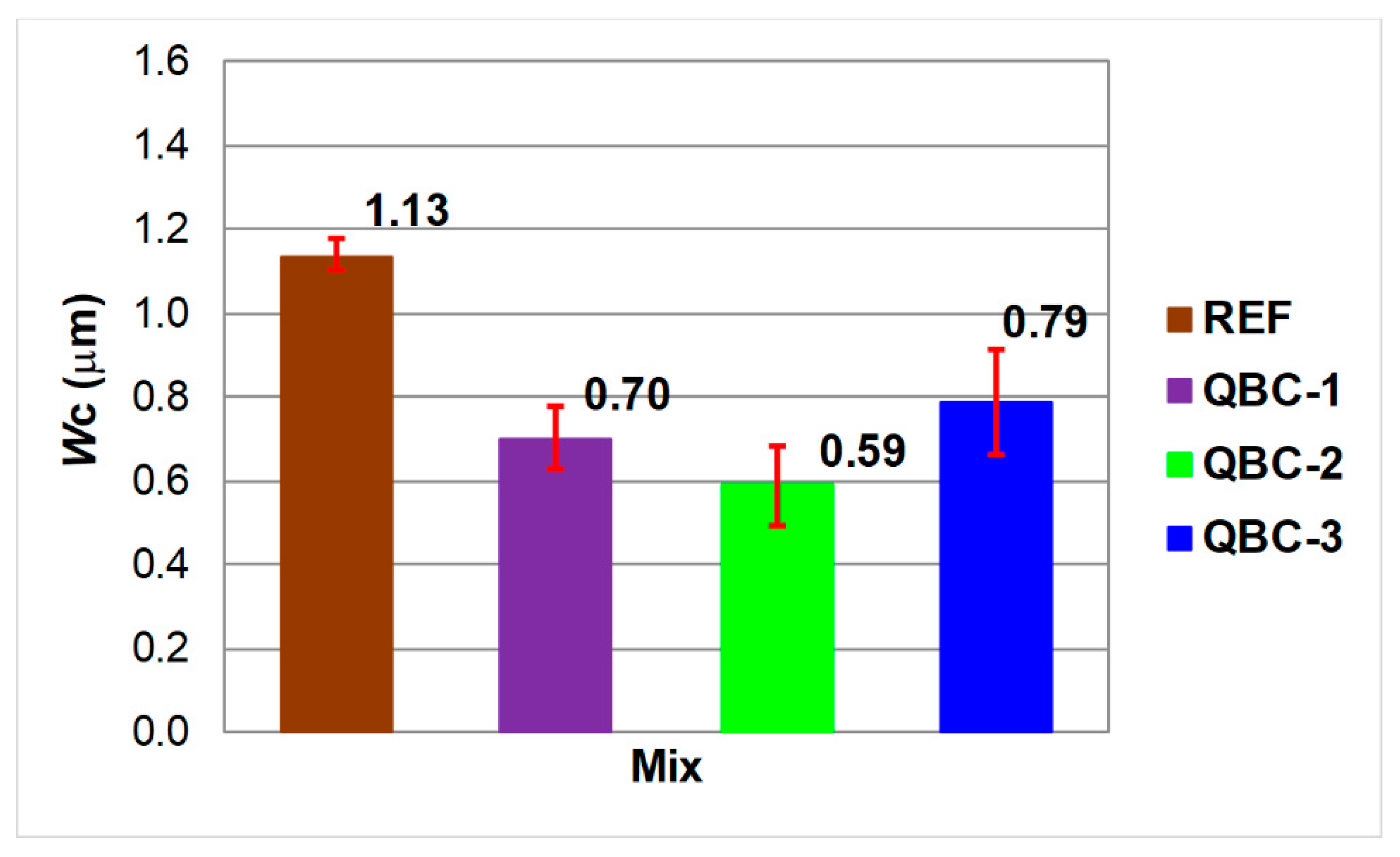

| Property | Unit | Aggregate Type | |
|---|---|---|---|
| Fine Aggregate (Sand) | Coarse Aggregate (Gravel) | ||
| Specific density | (g/cm3) | 2.60 | 2.65 |
| Bulk density | (g/cm3) | 2.20 | 2.25 |
| Compressive strength | (MPa) | 33 | 34 |
| Modulus of elasticity | (102 MPa) | 330 | 330 |
| Sand point for mix | (%) | 40.7 | |
| Material\Constituent | SiO2 | Al2O3 | CaO | MgO | SO3 | Fe2O3 | K2O | P2O5 | TiO2 | Ag2O |
|---|---|---|---|---|---|---|---|---|---|---|
| OPC | 15.00 | 2.78 | 71.06 | 1.38 | 4.56 | 2.72 | 1.21 | - | - | - |
| FA | 55.27 | 26.72 | 2.35 | 0.81 | 0.47 | 6.66 | 3.01 | 1.92 | 1.89 | 0.10 |
| SF | 91.90 | 0.71 | 0.31 | 1.14 | 0.45 | 2.54 | 1.53 | 0.63 | 0.01 | 0.07 |
| nS | >99.8 | - | - | - | - | - | - | - | - | - |
| Physical Parameter | Kind of Binder | |||
|---|---|---|---|---|
| OPC | FA | SF | nS | |
| Specific gravity (g/cm3) | 3.11 | 2.14 | 2.21 | 1.10 |
| Blaine’s fineness (m2/g) | 0.33 | 0.36 | 1.40 | 200 |
| Average particle diameter (μm) | 40 | 30 | 11 | 0.012 |
| Mix | OPC | %OPC | FA | %FA | SF | %SF | nS | %nS | Water | SP | Sand | Gravel |
|---|---|---|---|---|---|---|---|---|---|---|---|---|
| REF | 352 | 100 | 0 | 0 | 0 | 0 | 0 | 0 | 141 | 0 | 676 | 1205 |
| QBC-1 | 299.2 | 85 | 0 | 0 | 35.2 | 10 | 17.6 | 5 | 141 | 6 | 676 | 1205 |
| QBC-2 | 281.6 | 80 | 17.6 | 5 | 35.2 | 10 | 17.6 | 5 | 141 | 6 | 676 | 1205 |
| QBC-3 | 246.4 | 70 | 52.8 | 15 | 35.2 | 10 | 17.6 | 5 | 141 | 6 | 676 | 1205 |
| Parameter Type | Parameter Characteristics |
|---|---|
| Microscope used in the study | Quanta FEG 250 |
| The shape of the samples | Rectangular cube |
| Sample dimensions | 10 × 10 × 3 mm |
| Samples for testing | Taken as raw—the samples before the test were not polished or prepared in any other way |
| The course of the experiments | The tests were performed in both low and high vacuum |
| Sample preparations |
|
| Number of samples | Six samples for each series of concrete |
| Number of photos per sample | Thirty photos were taken for each sample, from which the representative photos were selected |
| The observed area of each concrete batch | About 3000 mm2 |
| Places included in the microscopic assessment |
|
| Magnifications used |
|
| Mix | Morphological Characteristics of Cement Matrix |
|---|---|
| REF |
|
| QBC-1 |
|
| QBC-2 |
|
| QBC-3 |
|
Disclaimer/Publisher’s Note: The statements, opinions and data contained in all publications are solely those of the individual author(s) and contributor(s) and not of MDPI and/or the editor(s). MDPI and/or the editor(s) disclaim responsibility for any injury to people or property resulting from any ideas, methods, instructions or products referred to in the content. |
© 2023 by the author. Licensee MDPI, Basel, Switzerland. This article is an open access article distributed under the terms and conditions of the Creative Commons Attribution (CC BY) license (https://creativecommons.org/licenses/by/4.0/).
Share and Cite
Golewski, G.L. Concrete Composites Based on Quaternary Blended Cements with a Reduced Width of Initial Microcracks. Appl. Sci. 2023, 13, 7338. https://doi.org/10.3390/app13127338
Golewski GL. Concrete Composites Based on Quaternary Blended Cements with a Reduced Width of Initial Microcracks. Applied Sciences. 2023; 13(12):7338. https://doi.org/10.3390/app13127338
Chicago/Turabian StyleGolewski, Grzegorz Ludwik. 2023. "Concrete Composites Based on Quaternary Blended Cements with a Reduced Width of Initial Microcracks" Applied Sciences 13, no. 12: 7338. https://doi.org/10.3390/app13127338
APA StyleGolewski, G. L. (2023). Concrete Composites Based on Quaternary Blended Cements with a Reduced Width of Initial Microcracks. Applied Sciences, 13(12), 7338. https://doi.org/10.3390/app13127338







